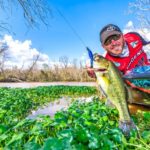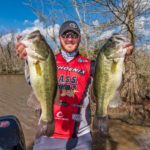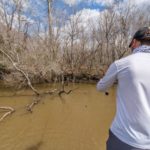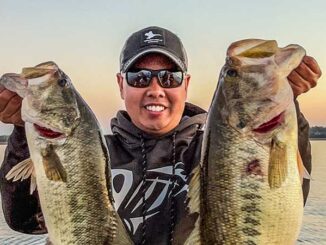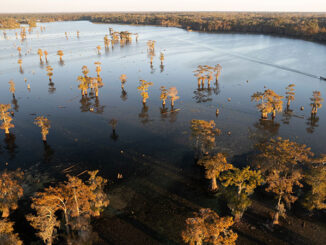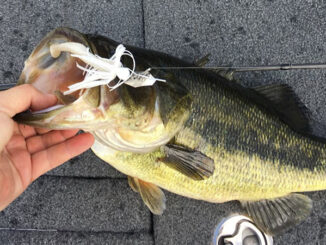
If you head to the Atchafalaya Basin dead-ends this month, you’ll likely struggle to put bass in the boat. But Louisiana’s newest Bassmaster Elite Series pro knows just where those fish have gone — and shares his approach to catching them.
Caleb Sumrall and Marcus Curry left the launch full of confidence. After a winter that saw horrifically cold temperatures, the water in the Atchafalaya Basin was hitting the 70s.
It took a while to figure out what was going on: Bass had already finished up their spawning business and had moved off the shallows.
The pair was working a stretch of bank, Sumrall pitching a soft-plastic creature bait and Curry working the waters with a spinnerbait.
Sumrall rocked the boat when he set the hook on a 1 ½-pounder.
About 30 minutes later, another hookset yielded a better bite.
“That’s a good one,” the Bassmaster Elite Series rookie grunted, and Curry hurried to get into position to lip the thrashing bass.
A 4-pounder went in the livewell.
By the end of the trip, two bass pushing 4 pounds were landed, along with a handful of typical Basin footballs.
Anglers moved in an out, working the banks hard. We didn’t see another fish caught.
The likely reason was that these fishermen hadn’t picked up on the fact that the beds were largely empty. Their boats were where fish were hanging.
Sumrall was excited, because he knows post-spawn bass are a lot less finicky than those sitting beds.
“They’re feeding up after the spawn,” said the pro, who competed in his first Bassmaster Classic last month. “They are aggressive.”
The key to consistently catching Basin bass right now will be understanding where bass will position themselves, Sumrall said.
Yes, this means the bass will be off the banks. But Sumrall said they also will be leaving the back ends of spawning canals.
So to find success you can’t fish where you caught bass last month.
“I start looking for muddy, moving water near dead-ends,” Sumrall explained. “You can catch fish moving from dead-ends to well-oxygenated water.”
Now, he said it’s not quite time to get out into the main, rolling bayous, but anywhere you find a bit of current moving along the bank can produce.
Even that sluggish current helps position bass to make targets predictable.
“I look for anything irregular on a long, straight bank,” Sumrall explained. “Anything that’s just a little bit different.”
The New Iberia pro loves to flip and punch Missile D-Bombs, but he’s not opposed to more active baits.
Kajun Boss spinnerbaits and 6th Sense Crush 50x crankbaits are regular parts of his Basin arsenal. Both lures allow him to cover a lot of water and locate productive stretches where he can slow down and pick them apart with soft-plastics.
But there are times when you just can’t go wrong with these moving lures.
The flash of a spinnerbait can put quick limits in the boat, particularly when bounced off wood.
Sumrall said he sticks with 3/8-ounce spinnerbaits, and he always adds a trailer.
“That’s just something to add a little something extra to the bait,” he said.
His approach is to cast it out and reel at a speed that keeps the lure at a point in the water column in which the blade flash is just out of sight.
He loves to add some flutter to the lure, letting it fall around any cover on its way back to the boat. But he doesn’t get stuck on one particular retrieve.
“I will try different casts every now and then, and let the fish tell me what they want,” Sumrall said.
A square-bill like the Crush 50X is just dynamite around open cover.
“It gets good reaction bites,” Sumrall said. “It’s not traditionally a big bait, but it moves a lot of water. Sometimes the fish will react to that when they won’t hit anything else.”
The following are more specifics on his approach to catching Atchafalaya Basin bass.
Laying it down
Sumrall covers a lot of water while searching for stringer-stretching bass, but he slows down and concentrates whenever he comes across a laydown extending into the water.
“There’s never a good time to pass up a laydown,” he said.
But he doesn’t just fire crankbaits or spinnerbaits into the tangle of branches.
“I’m going to fish the edge of the laydown and work my way inside,” Sumrall explained. “That way, if I catch fish on the outside I don’t’ disturb those (bass) on the inside (of the laydown).”
And he always begins with a soft-plastic creature bait.
“I don’t like to fish moving baits in there first,” the Bassmaster Elite Series rookie explained. “I’ve seen times when, if they don’t want a spinnerbait, they run from it.”
So he carefully fishes a soft-plastic through the branches, working his way into the center of the laydown.
Only when he’s satisfied he’s covered the entire fallen tree will he pick up a spinnerbait or square-bill.
“I’ll flip it real, real good (with a soft-plastic), and then come back and fish a moving bait through there,” Sumrall said. “It’s a way to maximize the laydown.”
Draining bass
Drains pulling water out of the flooded swamps of the Basin always attract bass, but Sumrall said this month they are especially productive.
“Any time you find a drain you want to fish it,” he said.
He said the reason is simple: The water seeping out of the swamps carries groceries into the main waterway.
“They’re there to eat,” Sumrall said.
He said any active drain should be probed, but there’s a clear signal of particularly productive run-outs.
“Birds at the mouth of a drain is always a tell-tale sign,” Sumrall said.
While he approaches laydowns cautiously, using slow-moving soft-plastics first, drains call for an aggressive approach.
“I start with moving baits,” Sumrall said.
These include Kajun Bass spinnerbaits and a 6th Sense Crush 50x, a small square-bill crankbait.
The reason he isn’t scared to throw these moving lures is that bass hanging around drains are ready to crunch anything swept out of the swamp.
“You can’t spook drain fish,” Sumrall said. “They’re there for a reason; they’re there to feed.”
Once he’s worked over a drain with moving baits, he switches to a soft-plastic (usually a Missile D-Bomb) and makes another pass.
“You can catch a vast number of fish in a drain,” he explained.
He said he ensures he fishes every part of the drain before moving on.
“You want to fish the two points of the drain, the drain itself and the down current side of the drain,” Sumrall explained.
Spinnerbait 101
Spinnerbaits can be deadly tools for post-spawn bass, and there are tons of options on the market.
But Marcus Curry of Kajun Boss Outdoor said there are some keys to ensuring you get the most out of the lures — and it all starts with quality components.
“I like a small, thinner wire because you get more vibration,” Curry said.
Of course, wire can be too thin, offering a ton of vibration but lasting just a few bites.
“If it’s too flimsy, it bends and breaks,” New Iberia pro angler Caleb Sumrall said.
Kajun Boss’ Gorilla Blades are built around a .032-gauge wire.
“It’s kind of a happy medium between being too flimsy and being too stiff,” Curry explained.
He also said his company uses stainless steel ball bearing swivels to ensure the back blades spin freely.
“When you stop it, the blade turns on the fall,” Curry said. “It basically never stops spinning.”
Kajun Boss features 24-karat gold-plated main blades to increase corrosion resistance, with just a ton of color options for the front blades.
The lure line also includes premium silicon skirts, which offer almost unlimited options.
“Basically, you can customize it to any color you want,” Curry said.
Of course, even the most-beautiful spinnerbait is worthless if the hook isn’t razor sharp. So Curry said his company uses black nickel hooks to ensure penetration.
Learn more about Kajun Boss lures at kajunboss.com.
